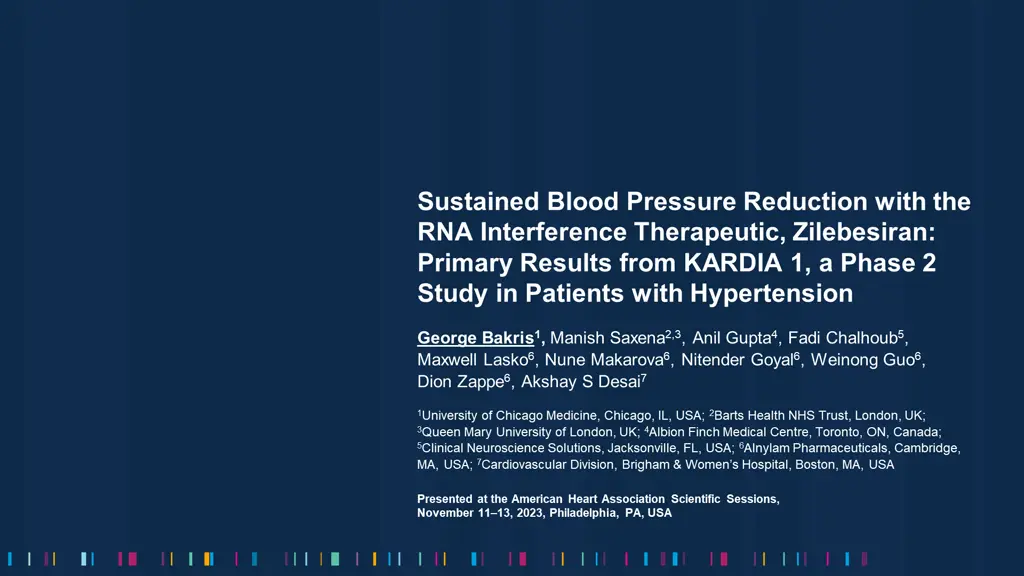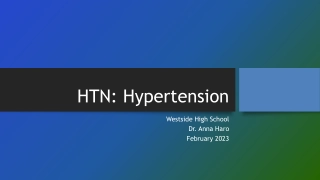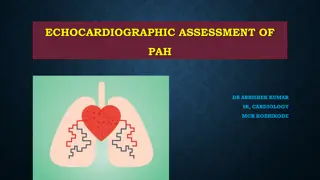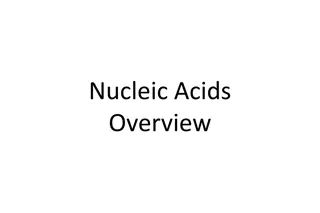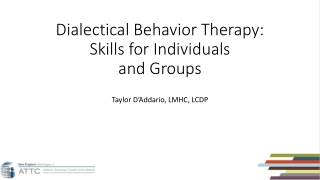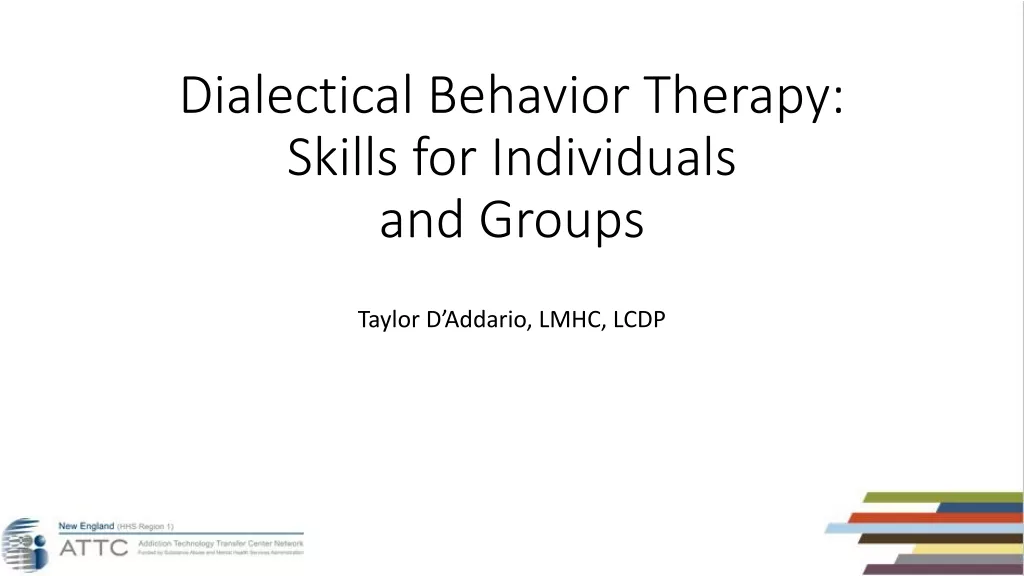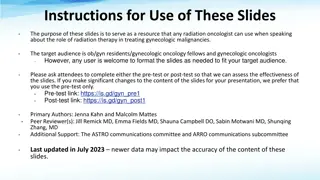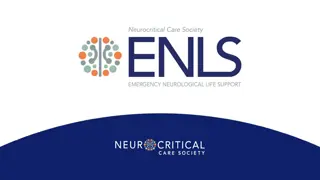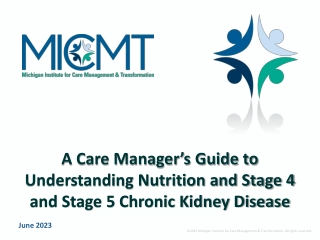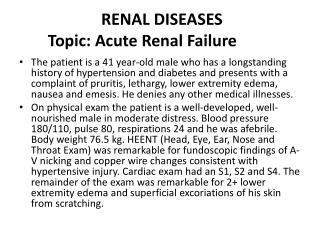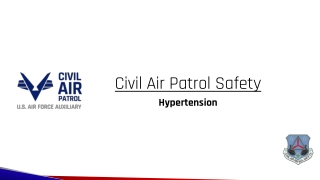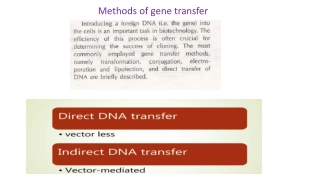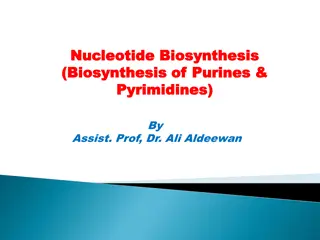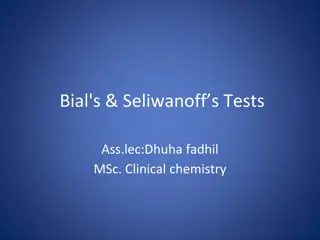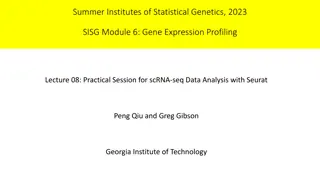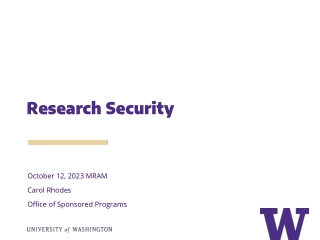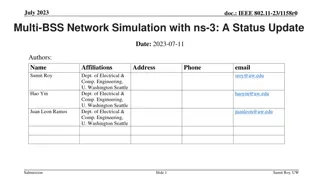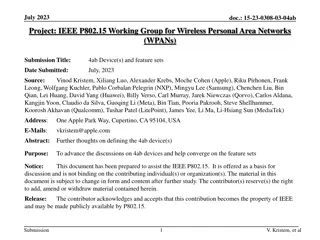RNA Interference Therapy Zilebesiran's Impact on Hypertension
Explore Zilebesiran, an investigational RNA interference therapeutic targeting hepatic AGT synthesis for hypertension. Primary findings from Phase 2 trial KARDIA-1 reveal sustained blood pressure reduction. Addressing the unmet need for innovative antihypertensive treatments.
Download Presentation
Please find below an Image/Link to download the presentation.
The content on the website is provided AS IS for your information and personal use only. It may not be sold, licensed, or shared on other websites without obtaining consent from the author. Download presentation by click this link. If you encounter any issues during the download, it is possible that the publisher has removed the file from their server.
Presentation Transcript
Sustained Blood Pressure Reduction with the RNA Interference Therapeutic, Zilebesiran: Primary Results from KARDIA 1, a Phase 2 Study in Patients with Hypertension George Bakris1, Manish Saxena2,3, Anil Gupta4, Fadi Chalhoub5, Maxwell Lasko6, Nune Makarova6, Nitender Goyal6, Weinong Guo6, Dion Zappe6, Akshay S Desai7 1University of Chicago Medicine, Chicago, IL, USA; 2Barts Health NHS Trust, London, UK; 3Queen Mary University of London, UK; 4Albion Finch Medical Centre, Toronto, ON, Canada; 5Clinical Neuroscience Solutions, Jacksonville, FL, USA; 6Alnylam Pharmaceuticals, Cambridge, MA, USA; 7Cardiovascular Division, Brigham & Women s Hospital, Boston, MA, USA Presented at the American Heart Association Scientific Sessions, November 11 13, 2023, Philadelphia, PA, USA 1
Presenter Disclosures GEORGE BAKRIS, MD SUSTAINED BLOOD PRESSURE REDUCTION WITH THE RNA INTERFERENCE THERAPEUTIC, ZILEBESIRAN: PRIMARY RESULTS FROM KARDIA 1, A PHASE 2 STUDY IN PATIENTS WITH HYPERTENSION FINANCIAL DISCLOSURE: George Bakris has received consulting fees from Alnylam Pharmaceuticals, AstraZeneca, Bayer, GlaxoSmithKline, InREGEN, Ionis, Janssen, KBP Biosciences, and Novo Nordisk. UNLABELED/UNAPPROVED USES DISCLOSURE: Zilebesiran is an investigational product in development for treatment of patients with hypertension. 2
An Unmet Need for Novel Antihypertensive Therapeutics Hypertension Uncontrolled hypertension is a leading cause of morbidity and mortality1,2 Despite availability of effective antihypertensives, many adults with hypertension are untreated and at least 75% have uncontrolled disease, both globally and in the USA3,4 Zilebesiran Mediates Hepatic AGT Reduction Liver-targeting ligand Zilebesiran siRNA Zilebesiran Zilebesiran is an investigational subcutaneous RNA interference therapeutic that targets hepatic AGT synthesis Phase 1 study data have demonstrated sustained, dose-dependent reductions in serum AGT levels and blood pressure through 24 weeks after a single dose of zilebesiran in patients with mild-to-moderate hypertension5 AGT Renin Objective KARDIA-1 was a Phase 2 study investigating the efficacy and safety of different doses of zilebesiran monotherapy in patients with mild-to-moderate hypertension Des(Ang1)AGT Angiotensin peptides AGT, angiotensinogen; des(Ang1)AGT, des(Ang1)angiotensinogen; GalNAc, N-acetylgalactosamine; RNA, ribonucleic acid; siRNA, small interfering ribonucleic acid. 1. Zhou B et al. Nat Rev Cardiol 2021;18:785 802; 2. Danaei G et al. PLoS Med 2009;6:e1000058; 3. World Health Organization. Hypertension. 2021. Available from: www.who.int/news-room/fact-sheets/detail/hypertension (Accessed September 14, 2023); 4. Centers for Disease Control and Prevention. Estimated hypertension prevalence, treatment, and control among U.S. adults. 2022. Available from: https://millionhearts.hhs.gov/data-reports/hypertension-prevalence.html (Accessed September 14, 2023); 5. Desai AS et al. N Engl J Med 2023;389:228 38. 3
: A Randomized, Double-Blind, Dose-Ranging Study of Zilebesiran in Patients with Mild-to-Moderate Hypertension Primary Endpoint Change from baseline at Month 3 in 24-hour mean ambulatory SBPb Placebo Q3M SC 1:1:1:1:1 RANDOMIZATION OR Key Secondary Endpoints Change from baseline at Month 3 in office SBPb Change from baseline at Month 6 in 24-hour mean ambulatory SBP Change from baseline at Month 6 in office SBP Proportion of patients with 24-hour mean ambulatory SBP <130 mmHg and/or reduction 20 mmHg without additional antihypertensive medications at Month 6 Patient Population (N=394) Zilebesiran 150 mg Q6M SC Adults 18 75 years of age with daytime mean SBP 135 mmHg and 160 mmHg by ambulatory BPM, after washout of previous antihypertensive medication for 2 4 weeksa OR Zilebesiran 300 mg Q6M SC OR Zilebesiran 300 mg Q3M SC OR Zilebesiran 600 mg Q6M SC Safety Endpoint Frequency of AEs Rescue antihypertensive medication was permitted after Month 3 assessments and was discontinued by Month 5 for Month 6 assessments Assessments of patients receiving or within 2 weeks of stopping rescue antihypertensive medication were excluded from analysis to investigate effects of zilebesiran monotherapy ClinicalTrials.gov registration number: NCT04936035. aPatients previously taking medication for hypertension must have been without antihypertensives for 2 weeks before randomization. Four weeks of washout was required for long-acting antihypertensive medications, such as long-acting diuretics (e.g., chlorthalidone) or CCBs (e.g., amlodipine).bFor analyses of Month 3 endpoints, zilebesiran 300 mg Q3M and Q6M data were pooled together. AE, adverse event; BP, blood pressure; BPM, blood pressure monitoring; CCB, calcium channel blocker; Q3M, every 3 months; Q6M, every 6 months; SBP, systolic blood pressure; SC, subcutaneous. 4
Baseline Demographics Were Balanced Across Groups Zilebesiran Placebo Total 150 mg Q6M 300 mg Q6M 300 mg Q3M 600 mg Q6M Randomized,na 76 78 73 75 76 378 Disposition Dosed, n 75 78 73 75 76 377 Completed DB period, n (%) 70 (92) 70 (90) 70 (96) 68 (91) 69 (91) 347 (92) Discontinued study during DB period, n (%) 5 (7) 8 (10) 3 (4) 5 (7)b 5 (7)b 26 (7) Discontinued study owing to AE, n 0 1 0 0 0 1 Analysis set,nc 75 78 73 75 76 377 Demographics and clinical characteristics Mean age, years 57 56 56 58 57 57 Male sex, n (%) 37 (49) 39 (50) 44 (60) 45 (60) 45 (59) 210 (56) 37 (49) 46 (59) 46 (63) 40 (53) 45 (59) BMI, 30 kg/m2, n (%) 214 (57) Race, n (%)d Asian 5 (7) 4 (5) 2 (3) 7 (9) 5 (7) 23 (6) Black or African American 18 (24) 20 (26) 17 (23) 19 (25) 19 (25) 93 (25) White 52 (69) 53 (68) 54 (74) 48 (64) 52 (68) 259 (69) 141.1 (8)/ 81.7 (8) 140.6 (9)/ 81.7 (8) 142.5 (9)/ 82.3 (9) 141.6 (8)/ 82.0 (9) 143.1 (9)/ 81.4 (8) 141.8 (8)/ 81.8 (8) 24-hour mean ambulatory SBP/DBP, mmHg (SD) 143.1 (13)/ 87.9 (11) 142.0 (11)/ 87.4 (10) 143.0 (11)/ 88.8 (9) 140.0 (11)/ 85.3 (9) 140.8 (11)/ 85.6 (9) 141.8 (12)/ 87.0 (9) Office SBP/DBP, mmHg (SD) eGFR 60 mL/min/1.73 m2, n (%) 64 (85) 68 (87) 70 (96) 69 (92) 68 (90) 339 (90) aDuring the study, 16 patients were randomized from Ukraine in January February 2022 before geographic conflict started. Owing to the challenge of data collection and cleaning, these patients were excluded from the analyses. bTwo patients in the 300 mg Q3M group and two patients in the 600 mg Q6M group who were discontinued from study treatment during the 6-month DB period are in the safety follow-up period at the time of data cut. These four patients do not have a Month 6 visit and are not considered to have completed the 6-month DB period. cAnalysis set comprised all patients who received study drug except those who were from Ukraine.dOne patient in the zilebesiran 150 mg Q6M group was American Indian or Alaska Native; one patient in the zilebesiran 300 mg Q3M group was Native Hawaiian or Other Pacific Islander. AE, adverse event; BMI, body mass index; DB, double blind; DBP, diastolic blood pressure; eGFR, estimated glomerular filtration rate; Q3M, every 3 months; Q6M, every 6 months; SBP, systolic blood pressure; SD, standard deviation. 5
Note: The slide is animated to show the zoomed-in version of the graph upon click - please view in presenter mode to see the animation Dose-Dependent Reductions in AGT Observed Through 6 Months Mean reductions in serum AGT were sustained to 6 months, with reductions of 88% for 150 mg Q6M, 93% for 300 mg Q6M, 98% for 300 mg Q3M, and 96% for 600 mg doses of zilebesiran Through Month 6, AGT reduction correlated with SBP change (r [95% CI]: 0.354 [0.298, 0.408]); data on file AGT, angiotensinogen; BL, baseline; CI, confidence interval; Q3M, every 3 months; Q6M, every 6 months; SBP, systolic blood pressure. 6
Note: The slide is animated to show Month 6 data upon click - please view in presenter mode to see the animation Significant Decreases in ABPM SBP with All Zilebesiran Regimens Change from Baseline to Month 3 in 24-Hour Mean Ambulatory SBP Change from Baseline to Month 6 in 24-Hour Mean Ambulatory SBP Placebo Placebo 150 mg Q6M 150 mg Q6M 300 mg Q6M and Q3M combined 300 mg Q6M 600 mg Q6M 600 mg Q6M 300 mg Q3M Month 3 (Primary Endpoint) Month 6 (Key Secondary Endpoint) 150 mg Q6M 300 mg Q6M 300 mg Q3M 600 mg Q6M 600 mg Q6M 150 mg Q6M 300 mg Q3M and Q6M 14.2 ( 18.9, 9.5), 14.1 ( 19.2, 9.0), p=4.2E 10 p=4.5E 06 16.7 ( 21.2, 12.3), p=1.0E 12 15.7 ( 20.8, 10.6), p=1.0E 12 p=5.8E 09 11.1 ( 15.8, 6.4), 14.5 ( 19.1, 9.9), p=1.8E 09 14.1 ( 18.9, 9.4), p=9.1E 09 LSMD vs placebo, mmHg (95% CI)a LSMD vs placebo, mmHg (95% CI) Blood pressure measurements were censored if taken while patients were receiving or within 2 weeks after stopping any rescue medication. aThe adjusted 95% CI and p value are based on Dunnett's test. ABPM, ambulatory blood pressure monitoring; BL, baseline; CI, confidence interval; LSM, least-squares mean; LSMD, least-squares mean difference; Q3M, every 3 months; Q6M, every 6 months; SBP, systolic blood pressure. 7
Note: The slide is animated to show Month 6 data upon click - please view in presenter mode to see the animation Significant Decreases in Office SBP with All Zilebesiran Regimens Change from Baseline to Month 3 in Office SBP Change from Baseline to Month 6 in Office SBP Placebo Placebo Placebo 150 mg Q6M 150 mg Q6M 150 mg Q6M 300 mg Q6M and Q3M combined 300 mg Q6M and Q3M combined 300 mg Q6M 600 mg Q6M 600 mg Q6M 600 mg Q6M 300 mg Q3M Month 3 (Primary Endpoint) Month 6 (Key Secondary Endpoint) 150 mg Q6M 300 mg Q6M 300 mg Q3M 600 mg Q6M 600 mg Q6M 150 mg Q6M 300 mg Q3M and Q6M 10.2 ( 15.1, 5.3), 9.6 ( 13.8, 5.3), p=1.3E 05 p=0.0025 12.0 ( 15.7, 8.3), p=8.0E 10 9.1 ( 13.4, 4.8), p=3.8E 05 p=5.9E 05 7.5 ( 12.4, 2.7), 10.5 ( 15.3, 5.7), p=2.5E 05 12.1 ( 17.2, 7.1), p=2.8E 06 LSMD vs placebo, mmHg (95% CI) LSMD vs placebo, mmHg (95% CI) Blood pressure measurements were censored if taken while patients were receiving or within 2 weeks after stopping any rescue medication. CI, confidence interval; LSM, least-squares mean; LSMD, least-squares mean difference; Q3M, every 3 months; Q6M, every 6 months; SBP, systolic blood pressure. 8
Consistent Treatment Response Observed with Zilebesiran The Proportion of Patients Meeting Response Criteria was Significantly Higher with All Zilebesiran Regimens Versus Placebo Treatment response was defined as 24-hour mean ambulatory BPM SBP <130 mmHg and/or reduction of 20 mmHg, without additional antihypertensives Zilebesiran Placebo (N=75) 150 mg Q6M (N=78) 300 mg Q6M (N=73) 300 mg Q3M (N=75) 600 mg Q6M (N=76) Response criteria met, n (%)a 5 (7) 24 (31) 37 (51) 29 (39) 36 (47) Zilebesiran vs placebo Odds ratio 6.75 19.73 10.73 17.93 95% CI 2.35, 19.37 6.84, 56.89 3.76, 30.64 6.24, 51.52 p value 0.0004 3.4E 08 9.3E 06 8.4E 08 Response rate defined as proportion of patients with 24-hour mean SBP assessed by ambulatory BPM <130 mmHg and/or reduction 20 mmHg without additional antihypertensive medications at Month 6. aAssessments are missing for 43 patients. BPM, blood pressure monitoring; CI, confidence interval; Q3M, every 3 months; Q6M, every 6 months; SBP, systolic blood pressure. 9
Consistent 24-Hour SBP Control Observed Through Month 3 Hourly Mean SBP and Change from Baseline in Hourly Mean SBP Assessed by Ambulatory BPM over 24 Hours Placebo (n=75) 150 mg Q6M (n=78) 300 mg Q6M (n=73) 300 mg Q3M (n=75) 600 mg Q3M (n=76) SBP data to Month 6 were consistent with SBP data to Month 3 DBP data to Month 3 and Month 6 were consistent with SBP data 10 Daytime is from 6:00 a.m. to 9:59 p.m. Nighttime is from 10:00 p.m. to 5:59 a.m. BPM, blood pressure monitoring; CI, confidence interval; Q3M, every 3 months; Q6M, every 6 months; SBP, systolic blood pressure.
Zilebesiran Had a Favorable Safety Profile Zilebesiran Zilebesiran total (N=302) Placebo (N=75) AE, n (%) 150 mg Q6M (N=78) 300 mg Q6M (N=73) 300 mg Q3M (N=75) 600 mg Q6M (N=76) 6 (8) 12 (15) 12 (16) 14 (19) 13 (17) 51 (17) At least 1 study drug-related AE At least 1 study drug-related AE leading to study drug discontinuation 0 1 (1) 1 (1) 1 (1) 1 (1) 4 (1) Study drug-related AEs (occurring in >5% of patients) 0 3 (4) 4 (6) 8 (11) 4 (5) 19 (6) ISR 1 (1) 4 (5) 3 (4) 4 (5) 5 (7) 16 (5) Hyperkalemia Additional TEAE of clinical interest (any relatedness) Acute renal failure 0 1 (1) 2 (3) 1 (1) 2 (3) 1 (1) 4 (5) 1 (1) 1 (1) 4 (1) 9 (3) 1 (1) Hepatic AE 1 (1) 3 (4) 3 (4) 3 (4) 4 (5) 13 (4) Hypotension 2 (3) 5 (6) 4 (6) 5 (7) 5 (7) 19 (6) Hyperkalemiaa No drug-related AEs were classified as serious or severe One death due to cardiopulmonary arrest occurred in a patient receiving zilebesiran; it was not classified as drug-related Drug-related AEs leading to discontinuation of zilebesiran were orthostatic hypotension (n=2), BP elevation (n=1), and ISR (n=1) Most ISR and hyperkalemia AEs were mild, transient, and did not require therapeutic intervention Hypotension AEs were mild or moderate in severity and transient; most did not require therapeutic intervention No clinically relevant changes in renal or hepatic function were observed Definitions based on MedDRA terminology.aHyperkalemia AEs include AEs mapped to the customized query of hyperkalemia, blood potassium increased, and blood potassium abnormal. AE, adverse event; BP, blood pressure; ISR, injection site reaction; MedDRA, Medical Dictionary for Regulatory Activities; Q3M, every 3 months; Q6M, every 6 months. 11
Conclusions In KARDIA-1, single subcutaneous doses of zilebesiran resulted in clinically meaningful and significant reductions in 24-hour mean SBP compared with placebo at Month 3, that were sustained through Month 6 Tonic blood pressure control was demonstrated by consistent 24-hour mean SBP reductions throughout the dosing period across all zilebesiran regimens Zilebesiran demonstrated an encouraging safety profile over 6 months; rates of serious or severe AEs were low, and only mild or moderate drug-related AEs were observed across all zilebesiran regimens Most ISR and hyperkalemia AEs were mild, transient, and resolved without intervention, incidence of hypotension events was low, and no clinically relevant changes in renal or hepatic function were observed Zilebesiran is being further evaluated as an add-on therapy for treatment of hypertension in the ongoing KARDIA-2 (NCT05103332) Phase 2 study Thank you to the patients, their families, investigators, study staff, and collaborators for their participation in the zilebesiran KARDIA-1 study 12 AE, adverse event; ISR, injection site reaction; SBP, systolic blood pressure.
